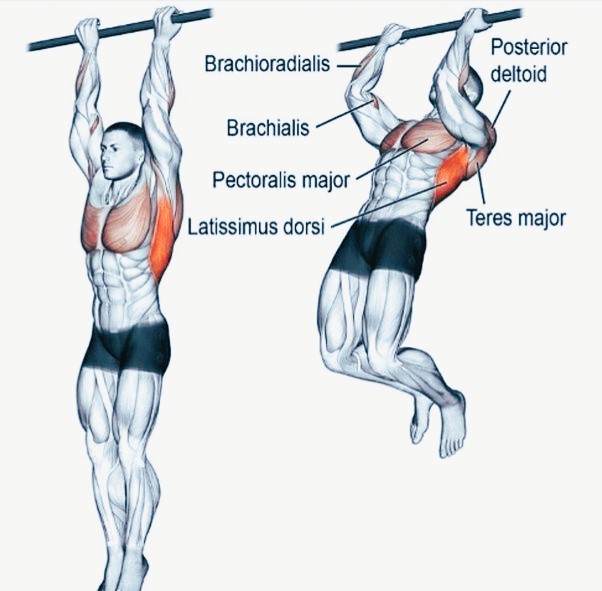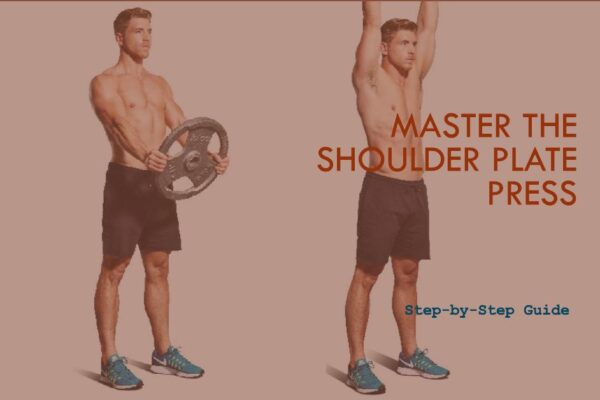Welcome to the world of strength training, where every lift, pull, and curl counts. A critical yet often overlooked exercise is the Reverse Grip Pullup. This powerful variation of the traditional pullup targets different muscle groups, offering unique benefits that can significantly enhance your upper body strength and physique.
But why should you incorporate this exercise into your routine? How do you perform it correctly? And what if you find it challenging? We’ll cover all these questions and more in this comprehensive guide. Whether you’re a seasoned fitness enthusiast or a beginner just starting, there’s something to learn about the mighty reverse grip pullup. So let’s start!”
What is a Reverse Grip Pullups?
Reverse grip pullups, also known as chin-ups, are a variation of the traditional pull-up exercise where you grip the bar with your palms facing you. This change in grip alters the muscles that are primarily targeted during the exercise.
Importance of Reverse grip pullups
Reverse grip pullups target biceps and brachialis muscles differently, promoting balanced muscle development. They improve grip strength, beneficial for weight lifting and daily tasks. These pullups increase functional fitness by engaging multiple joints and muscles. Thus, they enhance overall upper body strength and contribute to an effective workout regimen.
Anatomy and Muscles Worked
Muscles Targeted by the Reverse Grip Pullups
Reverse grip pullups primarily work the following muscles:
- Biceps Brachii: The main muscle in the upper arm, responsible for arm curling and lifting.
- Brachialis: Located under the biceps, it aids in elbow flexion.
- Brachioradialis: A muscle of the forearm that assists in elbow flexion.
- Latissimus Dorsi (Lats): Large muscles in the back that give you a V-shaped appearance.
- Rhomboids: Located in the upper back, they help retract the scapula.
- Trapezius: A large muscle extending down the back of the neck and upper spine, it helps move and stabilize the shoulder blades.
- Infraspinatus and Teres Major: Part of the rotator cuff, these muscles aid in shoulder rotation and stabilization.

Proper Technique for Reverse Grip Pullups
Proper technique is crucial when performing reverse grip pullups to ensure you’re getting the most out of the exercise and to avoid injury
A. Set-Up and Equipment Needed
To perform the Reverse Grip pull-ups, you’ll need the following equipment:
- You will need a sturdy pull-up bar installed at a height that allows your feet to be off the ground when hanging.
- Make sure there’s enough space around to perform the exercise without any obstructions.
B. Step-by-Step Guide
Here’s a detailed breakdown of how to execute the exercise correctly:
- Initial Position
- Stand under the pullup bar.
- Reach up and grab the bar with an underhand grip (palms facing towards you). Your hands should be shoulder-width apart.
- Hang from the bar, keeping your arms fully extended. Cross your feet at the ankles for stability
2. Execution of the Exercise:
- Begin by pulling your body upwards towards the bar. Keep your elbows close to your body.
- Continue to pull yourself up until your chin is above the bar. Remember to keep your core engaged and avoid swinging or using momentum to pull yourself up.
- Pause briefly at the top of the movement.
- Slowly lower yourself back down to the starting position, making sure to extend your arms fully.
3. Breathing Tips
- Inhale as you lower yourself down.
- Exhale as you pull yourself up.
Remember, form is more important than the number of reps. It’s better to do fewer pullups with correct form than many with poor form. If you find it challenging, you can start with assisted pullups using a band or machine until you build up enough strength to perform unassisted reverse grip pullups.
Reverse Grip Pullups Benefits
Reverse grip pullups offer several significant benefits:
- Strengthening the Back, Core, and Arms: The exercise effectively builds the back, core, and arms, including the inner lats.
- Building a Sexy Posterior Chain: Reverse grip pullups can help to tone and shape your posterior chain, contributing to an attractive physique.
- Better Muscle Contraction: This type of pullup allows for better muscle contraction, particularly in the biceps and forearms.
- Bodyweight Exercise: Being a bodyweight exercise, it doesn’t require any additional equipment and can be performed anywhere with a suitable bar.
- Targeting Multiple Muscle Groups: The reverse grip pullup targets the latissimus dorsi, rhomboids, teres major and minor, biceps, and triceps. Additionally, it engages the core, providing a comprehensive upper-body workout.
- Increased Grip Strength: This variation of pullup can also enhance your grip strength, which is beneficial for several other exercises and daily activities.
- Progress and Technique: With consistent training, you can make slow and steady progress with this exercise. It also encourages good technique and proper injury prevention, making it a valuable addition to any fitness regimen.
Variations for Pullups:
1. Weighted Reverse Grip Pullups
This variation involves adding extra weight using a weight belt, weighted vest, or by holding a dumbbell between your legs.
Technique and Execution:
- Secure the additional weight.
- Grip the bar with your palms facing you and hands shoulder-width apart.
- Start from a dead hang with arms fully extended.
- Pull yourself up until your chin is above the bar.
- Lower yourself in a controlled manner back to the starting position.
2. One-Arm Reverse Grip Pullups
This advanced variation involves performing the pull-up using only one arm.
Proper Form and Execution:
- Grip the bar with one hand, palm facing you.
- Start from a dead hang with the arm fully extended.
- Pull yourself up until your chin is above the bar.
- Lower yourself in a controlled manner back to the starting position.
- Repeat on the other side.
3. Band-Assisted Reverse Grip Pullups
This variation is perfect for beginners who can’t yet perform a full pull-up. It involves using a resistance band for assistance.
Step-by-Step Guide
- Secure a resistance band on the pull-up bar and place your knee or foot in it.
- Grip the bar with your palms facing you and hands shoulder-width apart.
- Start from a dead hang with arms fully extended.
- Use the band’s assistance to pull yourself up until your chin is above the bar.
- Lower yourself in a controlled manner back to the starting position.
Modifying the Pullups for Different Fitness Levels
Reverse grip pullups can be modified to cater to different fitness levels. Here’s how:
A. Beginners:
- Assisted Pull-Ups: If you’re just starting, you may not have the strength to lift your entire body weight. Assisted pull-ups can be done using a resistance band looped over the pull-up bar and placed under your feet or knees. This will help reduce the amount of weight you’re lifting.
- Eccentric Pull-Ups: Also known as negative pull-ups, this focuses on the lowering phase of the pull-up. You start at the top position (you can use a step or jump up), then slowly lower yourself down. This helps build strength and control.
B. Intermediate:
- Standard Reverse Grip PullUps: Once you’ve built up some strength, you can perform standard reverse grip pullups without assistance.
- Weighted Pull-Ups: For those who find standard reverse grip pull-ups too easy, adding weight can increase the challenge. This can be done using a weighted vest or a dip belt with weight plates.
C. Advanced:
- L-Sit Pull-Ups: This variation increases the difficulty by adding in core work. As you pull yourself up, bring your legs up so that your body forms an ‘L’ shape.
- One-Arm Pull-Ups: This is one of the most challenging variations, requiring significant strength. As the name suggests, you perform the pull-up with only one arm.
Remember, always prioritize form over quantity to avoid injury and get the most out of your workouts.
Tips to Maximize Results and Safety
Follow these tips to maximize results and ensure safety when performing reverse grip pull-ups:
A. Warm-Up: Always begin with a proper warm-up to prepare your muscles and joints for the workout.
B. Proper Grip: Use a shoulder-width grip, palms facing you. This engages your biceps more than a traditional pull-up.
C. Full Range of Motion: Start with your arms fully extended at the bottom and pull yourself up until your chin is above the bar.
D. Controlled Movement: Perform the exercise in a slow, controlled manner. Avoid jerky movements or using momentum to pull yourself up.
E. Engage Your Core: Keep your core engaged throughout the movement. This helps stabilize your body and makes the pull-up more effective.
F. Focus on Your Back: Remember, the primary muscles worked during pull-ups are your back muscles. Ensure you’re squeezing your shoulder blades together as you pull yourself up.
G. Breathe: Inhale as you lower yourself and exhale as you pull yourself up. Proper breathing can help power your movements and maintain your energy levels.
H. Rest: Give your muscles time to rest and recover between sets. Overworking can lead to injuries and hinder your progress.
I. Consistent Training: Consistency is key. Aim to include pull-ups in your routine 2-3 times per week for best results.
J. Progressive Overload: As you get stronger, consider adding weight or increasing reps to continue challenging your muscles and promoting growth.
By following these tips, you can optimize your results and maintain a safe workout routine.
Common Mistakes to Avoid
Here are some common mistakes to avoid when doing reverse grip pull-ups:
- Incorrect Grip Width: Using a grip wider than shoulder-width can strain your shoulders.
- Flaring Elbows: Keep your elbows close to your body during the movement.
- Limited Range of Motion: Ensure you extend fully at the bottom and pull up until your chin is over the bar.
- Rapid Movement: Perform the pull-up in a controlled manner instead of rushing through it.
- Half Repetitions: Aim for full repetitions to fully engage the muscles.
- Overusing Your Arms: Pull-ups mainly work your back muscles, so ensure you’re engaging them and not just pulling with your arms.
- Not Fully Extending Elbows: Always fully extend your elbows in each rep.
- Ignoring the Lowering Phase: Lower yourself in a controlled manner to benefit from the entire movement.
Remember, maintaining proper form is key to preventing injuries and getting the most out of your workout.
Comparing Reverse Grip Pullups to Other Bicep Exercises
Reverse grip pull-ups are a great choice for an intense, full-body workout that targets the biceps. However, other exercises might be more appropriate depending on your fitness level, equipment availability, and specific training goals.
| Exercise | Muscles Worked | Difficulty | Equipment Needed | Benefits |
|---|---|---|---|---|
| Reverse Grip Pull-ups | Biceps, Lats, Rhomboids, Trapezius | Intermediate to Advanced | Pull-up bar | Full body workout improves grip strength, and enhances upper body strength easier than pull-ups due to biceps engagement |
| Bicep Curls | Biceps, Brachialis | Beginner to Advanced | Dumbbells, Barbell | Isolates the biceps, easy to adjust weight, can be performed seated or standing |
| Hammer Curls | Biceps, Brachialis, Brachioradialis | Beginner to Advanced | Dumbbells | Works multiple muscles, enhances grip strength, can be performed seated or standing |
| Concentration Curls | Biceps | Beginner to Advanced | Dumbbells | Isolates the biceps, can help improve peak of bicep, done one arm at a time for focus |
| Chin-ups | Biceps, Lats, Rhomboids, Trapezius | Intermediate to Advanced | Pull-up bar | Full body workout, improves grip strength, enhances upper body strength, easier than pull-ups due to biceps engagement |
Incorporating Pullups into Your Workout Routine
Incorporating Reverse Grip Pullups into Your Workout Routine:
- When and How Often to Do Them: Reverse grip pull-ups are typically best performed at the beginning of your workout when your muscles are fresh. Aim to incorporate them into your routine 2-3 times per week, allowing for rest days in between to let your muscles recover.
- Complementary Exercises and Workouts: To balance out your training, pair reverse grip pull-ups with push exercises like push-ups or bench presses. This ensures you’re working both your ‘pull’ and ‘push’ muscles. Incorporate lower-body exercises like squats or lunges for a full-body workout. Also, consider adding in core work like planks or Russian twists to strengthen your midsection, which is engaged during pull-ups.
Frequent Question Answers
By addressing the following frequently asked questions, we hope to provide clarity and guidance on incorporating the Reverse Grip Pullups into your fitness routine. Remember to listen to your body, start at an appropriate level, and gradually progress for optimal results.
| FAQ | Answer |
|---|---|
| Can beginners do the reverse grip pull-up exercise? | Yes, beginners can do the reverse grip pull-up exercise, but it might be challenging as it requires a certain level of upper body strength source |
| What is the proper technique for a reverse grip pull-up? | Drive your elbows down to your hips and pull down on the pull-up bar as hard as you can until your chin reaches the bar. Slowly lower yourself. source |
| How does a reverse grip pull-up compare to a regular pull up? | The pull-up is an excellent exercise for building mass and strengthening the various back muscles, including the latissimus dorsi. source |
| Is the pull-up good for building mass and strengthening back muscles? | What groups of muscles does a reverse grip pull-up work? |
| What is the difference between wide, standard, and reverse grip pullups? | A recent study can help us understand what the difference is between wide, standard, and reverse grip pullups. It’s important to know the different muscle groups each variation targets. source |
| How does a reverse grip pull-up compare to a regular pull-up? | A pull-up will better target your upper back and put more pressure on the shoulder, while a reverse grip pull-up better targets your biceps. source |
| What is a Reverse Pull-Up? | Contrary to popular belief, a reverse pull-up does not refer to the hang grip used for the exercise. A “reverse grip” exercise means that the palms are facing towards the exerciser. source |
Conclusion
Reverse grip pull-ups are an excellent exercise for developing upper body strength and enhancing muscle definition, particularly in the biceps and back muscles. They not only offer a challenging workout but also promote better grip strength and core stability. By incorporating them into your routine 2-3 times per week, you can reap these benefits and more.
So, whether you’re a fitness novice or a seasoned athlete, consider adding reverse grip pull-ups to your regimen. With consistency and determination, you’ll soon notice improvements in strength, form, and overall fitness. Give them a try – your body will thank you!
Sources
- “How To Do The Reverse Grip Pull-Up: Exercise Technique, …” Fitness Volt. Source
- “How to Do Reverse Grip Pull-Ups: Benefits, Tips …” Sportskeeda. Source
- “What groups of muscles does a reverse grip pull up work?” Quora. Source
- “Mastering Bodyweight Reverse Grip Pull-ups.” Lyfta. Source
- “Reverse Grip Chin-Up.” Dmoose. Source
- “Reverse Chin Up.” The Hybrid Athlete. Source






Leave a Reply